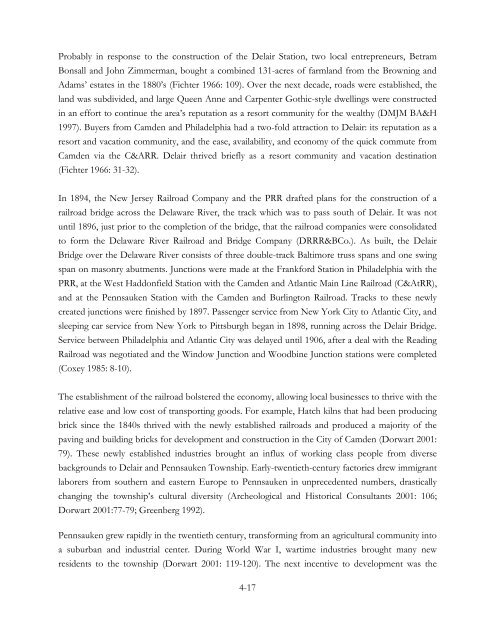APPENDIX D Cultural Resources Survey Report - US Environmental ...
APPENDIX D Cultural Resources Survey Report - US Environmental ...
APPENDIX D Cultural Resources Survey Report - US Environmental ...
You also want an ePaper? Increase the reach of your titles
YUMPU automatically turns print PDFs into web optimized ePapers that Google loves.
Probably in response to the construction of the Delair Station, two local entrepreneurs, Betram<br />
Bonsall and John Zimmerman, bought a combined 131-acres of farmland from the Browning and<br />
Adams’ estates in the 1880’s (Fichter 1966: 109). Over the next decade, roads were established, the<br />
land was subdivided, and large Queen Anne and Carpenter Gothic-style dwellings were constructed<br />
in an effort to continue the area’s reputation as a resort community for the wealthy (DMJM BA&H<br />
1997). Buyers from Camden and Philadelphia had a two-fold attraction to Delair: its reputation as a<br />
resort and vacation community, and the ease, availability, and economy of the quick commute from<br />
Camden via the C&ARR. Delair thrived briefly as a resort community and vacation destination<br />
(Fichter 1966: 31-32).<br />
In 1894, the New Jersey Railroad Company and the PRR drafted plans for the construction of a<br />
railroad bridge across the Delaware River, the track which was to pass south of Delair. It was not<br />
until 1896, just prior to the completion of the bridge, that the railroad companies were consolidated<br />
to form the Delaware River Railroad and Bridge Company (DRRR&BCo.). As built, the Delair<br />
Bridge over the Delaware River consists of three double-track Baltimore truss spans and one swing<br />
span on masonry abutments. Junctions were made at the Frankford Station in Philadelphia with the<br />
PRR, at the West Haddonfield Station with the Camden and Atlantic Main Line Railroad (C&AtRR),<br />
and at the Pennsauken Station with the Camden and Burlington Railroad. Tracks to these newly<br />
created junctions were finished by 1897. Passenger service from New York City to Atlantic City, and<br />
sleeping car service from New York to Pittsburgh began in 1898, running across the Delair Bridge.<br />
Service between Philadelphia and Atlantic City was delayed until 1906, after a deal with the Reading<br />
Railroad was negotiated and the Window Junction and Woodbine Junction stations were completed<br />
(Coxey 1985: 8-10).<br />
The establishment of the railroad bolstered the economy, allowing local businesses to thrive with the<br />
relative ease and low cost of transporting goods. For example, Hatch kilns that had been producing<br />
brick since the 1840s thrived with the newly established railroads and produced a majority of the<br />
paving and building bricks for development and construction in the City of Camden (Dorwart 2001:<br />
79). These newly established industries brought an influx of working class people from diverse<br />
backgrounds to Delair and Pennsauken Township. Early-twentieth-century factories drew immigrant<br />
laborers from southern and eastern Europe to Pennsauken in unprecedented numbers, drastically<br />
changing the township’s cultural diversity (Archeological and Historical Consultants 2001: 106;<br />
Dorwart 2001:77-79; Greenberg 1992).<br />
Pennsauken grew rapidly in the twentieth century, transforming from an agricultural community into<br />
a suburban and industrial center. During World War I, wartime industries brought many new<br />
residents to the township (Dorwart 2001: 119-120). The next incentive to development was the<br />
4-17

















